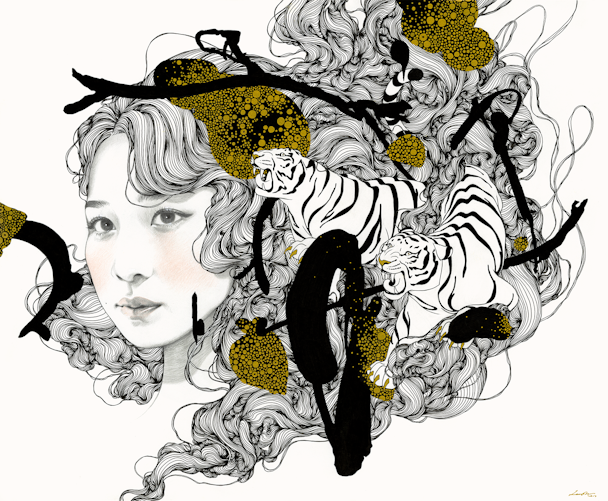
Advertisement

Artist Tran Nguyen is part of Tiger Beer & WWF campaign to save tigers / Tran Nguyen/Tiger
We talk to Tiger Beer’s Mie-Leng Wong about the brand’s plans to unleash Asian creativity.
Tiger Beer’s global brand platform ‘Uncage’ isn’t just a useful metaphor derived from its namesake but a descriptor of how the brand is taking on a bravery not seen so often in Singapore and Southeast Asia.
From its Cannes Lions-winning ‘Air-Ink’ work which turned pollution into ink in an outdoor ad to its latest purpose-led initiative ‘#3890tigers’ which raises awareness of the small number of tigers left in the wild, the Singaporean brand is giving the world a masterclass in meaningful, innovative advertising.
As Mie-Leng Wong, the global director of Tiger Beer at Heineken Asia Pacific, says: “Asia is booming with young potential, ready to change the world. It just takes courage to ‘uncage the tiger inside’ to create positive impact. Creativity is extremely important to us and it is in Tiger’s brand DNA to support creative minds and unconventional thinkers. We want to leverage our global reach and marketing power to provide a platform where ideas can be turned into action.”
This new direction took shape three years ago, according Wong, and was driven first and foremost by the brand before being handed to its agencies to build on. This, she believes, is what has taken 84-year-old Tiger to new heights globally. She says the foundation of the idea should be driven by the brand, but the recent string of successes has come from forging the right collaborations.

“It is important for a brand to first establish a strong brand platform that has longevity. For us, ‘Uncage’ acts as a creative springboard to always draw inspiration from and to help us shape ideas that are unconventional while still true to Tiger’s brand identity. This was developed by, and should be owned by, the brand teams.
“With a solid platform in place, the creative possibilities are endless. We have worked with creative agencies such as Marcel Sydney, JKR Singapore, Ogilvy PR and SapientRazorfish, and we recognize the value in collaborating as it allows us to challenge each other to grow the idea into something even bigger and bolder.”
Being bold for the sake of being bold doesn’t work, however, so Tiger’s new strategy links to two important factors to keep it relevant: purpose and authenticity.
“When I started on Tiger the brand strategy was very western focused. For years, Asian brands had been seeking western validation, but the tide has turned. Asian consumers increasingly value brands that are authentic and true to their roots and the west is looking to Asia for inspiration now. Look at fashion designers like Alexander Wang and the impact Asian chefs are having on global food culture; Asia is not the factory of the world anymore but a hotbed for innovation, creativity and design. As Asia’s premium beer with global reach, we have a role to play in that.”
Two of the brand’s recent campaigns, ‘Air-Ink’ and ‘#3890Tigers’, are rooted in purpose. For the latter, the goal is to position the purchase of products containing tiger parts as socially unacceptable and it will be working closely with the WWF over the next few years to create action.
“We believe that all ideas might start small, but anyone who dares to take the path less traveled can make a difference. We will continue to provide global platforms where the positive impact of creativity and talent from the streets can be showcased to the world.”

The purpose-led route is trodden by many brands, particularly those coveting the younger, socially savvy audiences, but to truly stand out means finding new ways to communicate and creating a point of difference from competitors. And Wong believes brands are falling into a trap in which there is a preference for ideas that have already been proven, which makes it impossible to be innovative.
“Creative successes from other brands are used as a benchmark. This is what can potentially cause brands to sometimes be overly cautious to the point where creativity can be compromised. First and foremost, we should strive to be original and create work that will cut through. And to achieve this you sometimes have to take a leap of faith. Be brave and take a risk.”
Wong uses the example of meeting the inventor of Air-Ink, Anirudh Sharma. Tiger decided to support him because his work “exemplified” the ‘Uncage’ idea, “even though there was some hesitation from local markets in the beginning”.
While the brand has a remit to champion local talent, it didn’t go all-in at once, which Wong believes was useful in pushing bravery in local markets that weren’t convinced. “In my experience it helps to create a pilot. We first piloted Tiger Air-Ink in Hong Kong and when CNN and others picked it up, it bred confidence that this idea had the potential to garner significant PR and earned media. It allowed us to scale up to six other markets.”
One of Singapore’s many nicknames is the Little Red Dot, which is used to describe its economic power despite being so small on a map. Despite this it isn’t often considered a creative city, although many would argue this is changing very quickly. It is, however, pragmatic and famed for collaboration – qualities evident in Tiger’s strategy.
“Tiger is born and bred in Singapore and the recent win at this year’s Cannes Lions is proof that a brand from Singapore can deliver creativity on a global stage. We will take learnings from this experience and also hope that this inspires more Singapore brands to be bold with their creative thinking, explore the path less traveled and reap the benefits.”
This feature is from the Singapore installment of The Drum's Creative Cities series, which is sponsored by The Trade Desk and published alongside our September issue of the magazine. Become a member of The Drum+ to get your hands on a copy.